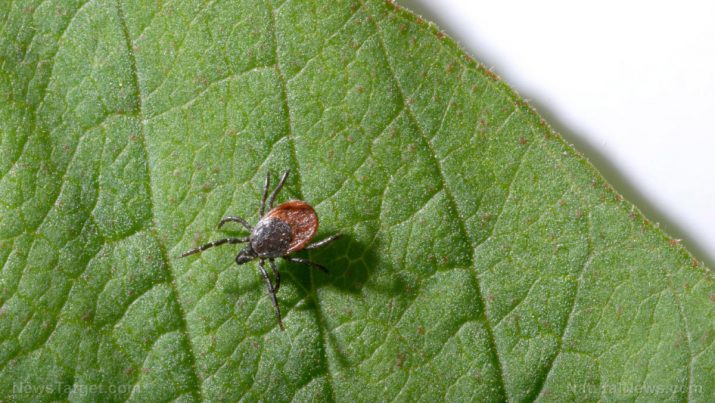
Crimean-Congo hemorrhagic fever – causes, side effects and treatments at NaturalPedia.com
Thursday, February 22, 2018 by Janine Acero
http://www.naturalpedia.com/crimean-congo-hemorrhagic-fever-causes-side-effects-and-treatments-at-naturalpedia-com.html

The Crimean-Congo hemorrhagic fever (CCHF) is a type of viral hemorrhagic fever, which belongs to a group of illnesses that affect many organs in the body. Viral hemorrhagic fevers are caused by several distinct families of viruses. As the name suggests, these illnesses can cause bleeding or hemorrhage by damaging blood vessels.
CCHF is caused by a tick-borne virus called Orthonairovirus. It was first described in Crimea in 1944, and was later also described in Congo, hence the name. It is endemic in Africa, the Balkans, the Middle East and some Asian countries.
Ticks carry the virus from animal to animal and from animal to human. The disease is spread through the following exposures:
- Through infected tick bites
- Through contact with the blood of an infected animal
- Through person to person transmission if someone has close contact with the blood or body fluids of an infected individual
The CCHF virus infects a wide range of domestic and wild animals.

Known symptoms and risk factors of Crimean-Congo hemorrhagic fever
The onset of CCHF is sudden. Initial symptoms consist of high fever, headache, back and joint pains, vomiting and abdominal pain. Other symptoms include sore/red eyes, flushed face, jaundice, redness of the throat, fast heart rate, enlarged lymph nodes and “petechial rash,” or red spots on the palate caused by bleeding into the skin.
As the disease progresses, patients may develop larger bruises and may experience other bleeding problems, such as severe nosebleeds or bleeding from injection sites (for those who were given a shot or an IV).
The following people are at an increased risk for contracting the CCHF virus:
- People who herd goats, slaughterhouse workers, and livestock workers in endemic regions.
- Healthcare workers in these regions who are exposed to infectious body fluids and infectious blood of patients.
- International travelers who come into contact with livestock in endemic regions.
Body systems harmed by Crimean-Congo hemorrhagic fever
The patient can bleed from any organ – from the bowel leading to the vomiting of blood (often confused with a stomach ulcer). Severe cases also exhibit passing of bloody stools, bleeding from the nose or gums, skin bruises, or bleeding into muscles (haematomata).
Food items or nutrients that may prevent Crimean-Congo hemorrhagic fever
A variety of items found in your kitchen or medicine cabinet can be excellent bug repellents and effective ingredients in anti-tick solutions. These items include:
- Aromatherapy oil – Aromatherapy oils like basil, lemon, cinnamon, cedar, lavender, eucalyptus, and tea tree oil are the natural repellent for ticks.
- Neem oil – Neem oil is a common remedy against ticks due to its antibacterial and antiseptic properties.
- Apple cider vinegar – Prepare an anti-tick solution with eight oz. of apple cider vinegar mixed with four oz. of warm water. Stir it while adding half a teaspoon each of salt and baking soda. You can also use apple cider vinegar with lavender oil or neem oil for a potent anti-tick solution.
- Witch hazel – A witch hazel and eucalyptus oil solution is an effective spray solution against ticks.
- Lemon juice – Use a fresh lemon juice directly on ticks or affected area. You can also prepare a spray with lemon juice mixed with other ingredients, like peppermint oil and citrus oil. Mix all the substances equally and spray it on required places.
Treatment, management plans for Crimean-Congo hemorrhagic fever
There is no specific treatment for CCHF. Patients are given general supportive care, such as fluids, electrolytes, oxygen and treatments for the symptoms. A drug known as ribavirin has also shown some benefits for patients with the disease.
Oral and intravenous formulations of the antiviral drug ribavirin has been used to treat CCHF infection.
Where to learn more
- Bill Gates quietly funding effort to develop thousands of new vaccines that conveniently ‘might’ become pandemics
- One third to die by plague or famine; one third will fall by the sword; one third to be scattered to every wind
- Touch is the most basic sense: Even bacteria use it to navigate their environment and communicate
- Homeopathic and herbal remedies for surviving bioterrorism attacks – A disaster plan for emergency preparedness
- WHO warns of high risk of global epidemic from emerging diseases
Summary
The Crimean-Congo hemorrhagic fever is a type of viral hemorrhagic fever caused by a tick-borne virus called Orthonairovirus. It damages blood vessels, causing bleeding or hemorrhaging.
CCHF is endemic in Africa, the Balkans, the Middle East and some Asian countries.
Ticks carry the virus from animal to animal and from animal to human.
Sources include:
Tagged Under: Tags: Crimean-Congo hemorrhagic fever





